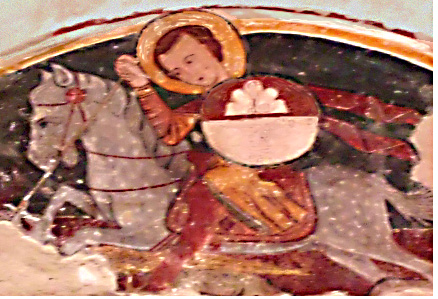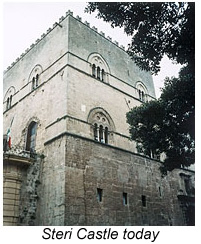...Best of Sicily presents... Best of Sicily Magazine. ... Dedicated to Sicilian art, culture, history, people, places and all things Sicilian. |
by Vincenzo Salerno | ||
Magazine Index Best of Sicily Arts & Culture Fashion Food & Wine History & Society About Us Travel Faqs Contact Map of Sicily |
But the Chiaramonte family also left a less dignified mark on Sicilian history: Treason. And in the Middle Ages disloyalty, especially by feudal nobles, was a serious offence indeed, however frequently it occurred. Andrew Chiaramonte was the culprit who faced justice by execution in 1392 in front of his majestic castle in Palermo. But he was not the only guilty party in his family. Yet a memory of the Chiaramontes endures symbolically in heraldry. In typical fashion, their coat of arms was defaced. However, a twentieth century restoration of the Steri Castle brought to light two examples - the fresco shown here (possibly depicting Manfred with an ironic halo) and a bas relief shield of simple design in white stone high on the castle's exterior wall. The coat of arms itself is simple, the stylized white mounts literally representing the surname, "white mountain." What path led Andrew to the point of trial and beheading? In some ways he was a victim of his times, and of his family's politics. His father, Manfred III Chiaramonte, controlled Trapani, Agrigento, Licata, Bivona Scicli and Messina, and held a position of trust from the crown. The problem was that the crown itself was contested, not only between the Angevins (who ruled southern Italy from Naples) and the Aragonese (who ruled Sicily from north-eastern Spain), but - at least briefly - by two branches within the Aragonese dynasty. In 1389, Manfred's daughter (Andrew's sister), Constance, was wed to the future king of Naples and Hungary, Ladislas of Anjou, who was then only thirteen.
Frederick III of Aragon died in 1377, and his young daughter, Mary was effectively "kidnapped" by the so-called "Four Vicars," powerful feudal lords who sought to govern Sicily without royal authority by retaining custody of the young girl. One of these "vicars" was Manfred. The others were Artale of Alagona (Mary's official guardian), Francis Ventimiglia and William Peralta. Alagona was, in effect, forced into forming a loose government by the other three. What followed reads like a textbook case of feudal chaos in the absence of a strong king. Each of the greedy vicars had their own allegiances, either to Aragon or to the Papal-Neapolitan influences who wanted to seize control of the island a century after the Vespers War. Their destructive private feuds destroyed much of the heartland. King Peter IV of Aragon eventually sought to restore order - and his dynasty's rights - in Sicily. An Aragonese fleet rescued Mary at Licata, east of Agrigento, in 1382. For the moment, reconquering the entire island was out of the question. Even so, the four vicars knew they couldn't defy the crown forever. Mary was wed to her cousin, King Martin of Sicily, who planned a full-scale invasion of the island that was his by right. At a meeting arranged by Manfred Chiaramonte in Castronovo in the Sicanian Mountains in June 1391, Alagona, Peralta and Ventimiglia decided to treat with the king, claiming (falsely) that the Chiaramonte clan alone had plotted the revolt against royal authority and begging for clemency. The accusation seemed credible in view of the great extent of Chiaramonte influence and the betrothal of Constance Chiaramonte to Aragon's rival, Ladislas of Naples. Manfred himself died in November, succeeded by his arrogant son. Martin arrived at Palermo in 1392 with a powerful fleet. Following a month-long siege, which included several assaults on the Steri Castle (then slightly closer to the shore than it is today) housing the Chiaramontes, the family capitulated. Andrew was executed on the first day of June. As a kind of postscript, young Ladislas of Anjou decided, in view of the Chiaramontes' disgrace, to divorce Constance a month later. The match no longer seemed a convenient one. So ended the opportunist Chiaramontes' closest step to a crown. About the Author: Palermo native Vincenzo Salerno has written biographies of several famous Sicilians, including Frederick II and Giuseppe di Lampedusa. This article is the first in our Historic Families series. | |
Top of Page |
 Nobody can agree
on where Sicily's long-extinct Chiaramonte family came from, but it is possible
that they were of French stock and originally were known as de Clermont,
for the city in Picardy. By the early years of the thirteenth century they
held important positions at the court of
Nobody can agree
on where Sicily's long-extinct Chiaramonte family came from, but it is possible
that they were of French stock and originally were known as de Clermont,
for the city in Picardy. By the early years of the thirteenth century they
held important positions at the court of  To say that the Chiaramonte
family had divided loyalties would be an understatement. On the one hand,
they were vassals of the King of Sicily. On the other, Manfred couldn't
resist the chance to see his daughter become Queen of Naples.
To say that the Chiaramonte
family had divided loyalties would be an understatement. On the one hand,
they were vassals of the King of Sicily. On the other, Manfred couldn't
resist the chance to see his daughter become Queen of Naples.